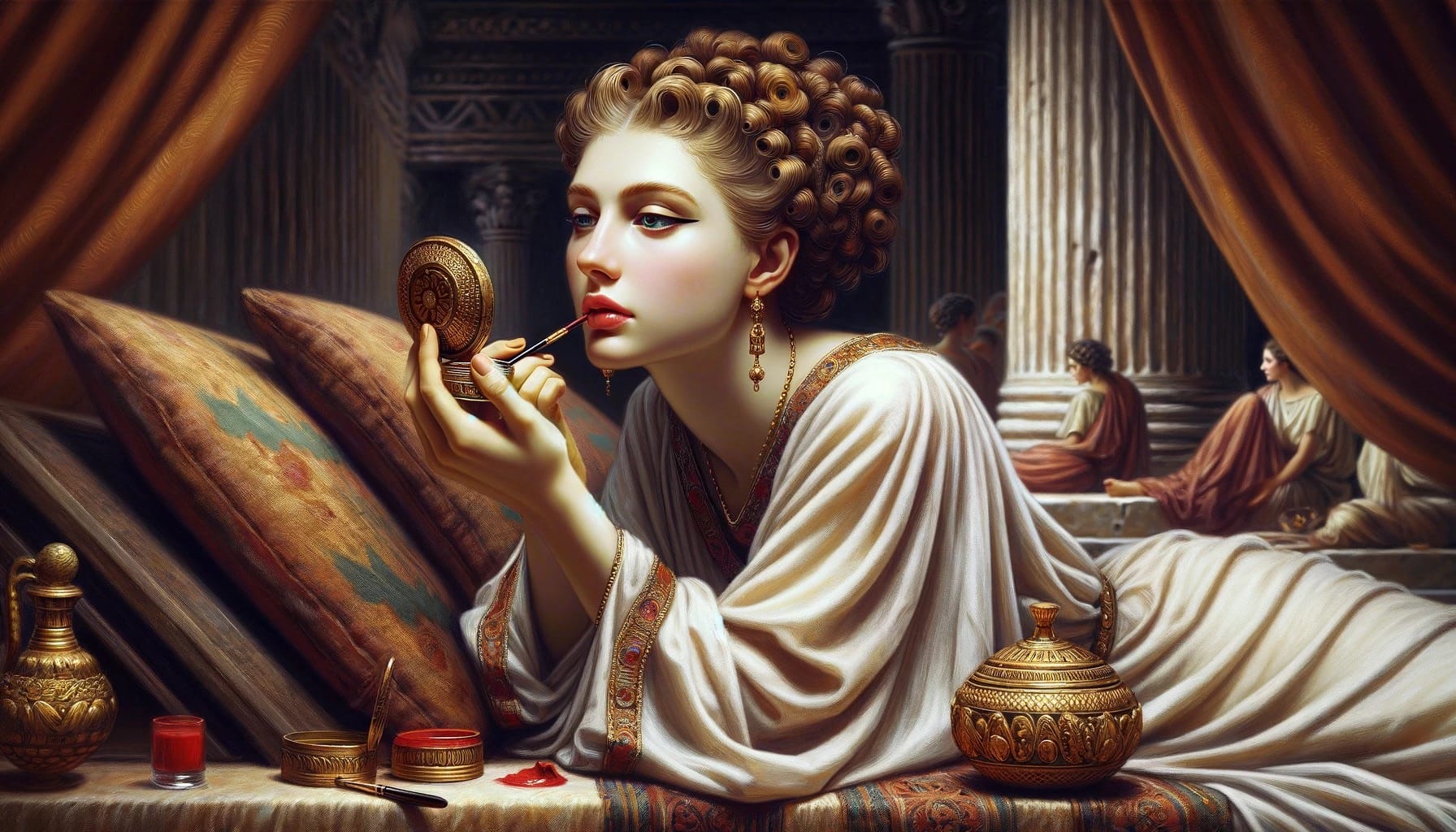Beauty in ancient Rome: Unveiling the Secrets of eternal elegance
How did the ancient Romans take care of their face and bodies? What were the absolute standards and what types of cosmetics were they using?

In the heart of Ancient Rome, beyond the grandeur of its architecture and the depth of its philosophical inquiries, lay a society deeply engrossed in the pursuit of beauty. The Romans, known for their intricate baths and elaborate grooming rituals, embarked on a quest for personal adornment that speaks volumes about their values, innovations, and the lengths they would go to enhance their appearance. In the sophisticated world of beauty in the Roman Empire, cosmetics were more than mere vanity—they were a testament to one’s status, health, and morality.
Foundations of Beauty: Skincare and Cosmetics
The cornerstone of Roman beauty lay in their skincare, believed to be essential for a clear and glowing complexion.
The body as well as the face had to be without any hair or wrinkles. A wrinkle – remover was lomentum, a mixture of bean-meal and rice kneaded together, used by the Roman ladies for preserving the smoothness of their skin.
Hair removal in ancient times extended beyond the face, encompassing areas like the beard, lips, cheeks, nostrils, legs, arms, underarms, and other body parts. Various methods were used for this purpose, including tweezing, trimming, shaving with a bronze razor, exfoliating with pumice stones, and applying specific unguents or pitch. Pliny the Elder, in his "Naturalis Historia," details several recipes for depilatory creams, with ingredients ranging from the blood, bile, and liver of certain sea fish, leeches, and a type of frog, to substances derived from ivy. These mixtures, which could also treat lice, had to be applied after hair removal for effectiveness, highlighting that these preparations might not always work as hoped.
The most valued pumices were white, lightweight, porous, and easily crumbled without being gritty. Shaving was introduced to Italy around 300 B.C., with Scipio Africanus Minor noted as the first Roman to shave regularly. While young men might experiment with unique shaving styles and even smooth their legs, it was expected for young women to have smooth legs and for everyone to maintain hair-free underarms for hygiene. Facial attractiveness was judged by a set of criteria that included a complete set of white teeth, two healthy eyes, long dark eyelashes, brows that were dark, well-defined, and met in the middle, and, importantly, a clear and soft complexion.
The eyebrows had to meet between the eyes. If they failed to meet, they were painted in.

To enhance skin complexion and texture, various natural ingredients were recommended for use either singly or in more complex formulations tailored for different skin needs, as described by Ovid in "Medicamina Faciei Femineae" and by Pliny the Elder. Honey, particularly from Attica, was a popular base for these concoctions, acting as a binder that made the mixtures easier to apply and also softened the skin. Similarly, a paste made from barley was used for its skin-softening properties. These bases might be combined with a variety of ingredients including frankincense to smooth skin irregularities, niter, myrrh, Ammon salt (a gum-resin found near the Ammon shrine in North Africa, obtained from a specific tree and collected in lumps from the surrounding sand), white lead, ground stag's horns, dried rose petals, narcissus bulbs, fennel, vetch, spelt, lupines, and beans.
These components were chosen for their abilities to tighten the skin, reduce wrinkles, and enhance overall skin appearance. Eggs and a mysterious sea-derived substance, described by Pliny as either the dense filth of sea foam or a woolly sea material, were also used. Each ingredient served a specific purpose, such as healing skin flaws, enhancing skin brightness, and stimulating a healthier color and scent.
A series of beauty specialists authored guides on the care and enhancement of skin and hair, offering numerous treatments. By the late second century A.D., a reference is made to Crito, who is noted for consolidating the knowledge from other works on the topic into a comprehensive four-volume series. Among these specialists, the poet Ovid is notable. He contributed a work, albeit in fragmentary form, consisting of around a hundred verses titled "Medicamina Faciei Femineae," which includes detailed recipes for elaborate facial treatments. One notable recipe can be found in this collection (verses 69-82):
Fail not lupines pale to treasure,
Parch them and the swelling bean,
Take six pounds of each - due measure;
Crush them with the black mill's pressure.
Spume of niter's ruddy sheen,
White lead, and Illyric iris,
One ounce each what you require is,
When strong youths have rubbed it fine.
Alcyonea, stuff they make from
Nests of sad sea birds, will take from
Faces spots o'er which you pine;
Just a half an ounce is needed.
Then when all my words you've heeded,
Mix all smooth in honey clear,
Ready on your face to smear
Romans favored natural ingredients, harnessing the earth's bounty to create concoctions that cleansed, moisturized, and perfected the skin. Honey, olive oil, and milk were staples in their skincare regimen, providing the necessary hydration and antibacterial protection. Notably, the use of lead-based concoctions to achieve a pale, ethereal glow underscores the lengths to which Romans would go, despite the potential health risks—a testament to beauty standards that valued fairness and an unblemished complexion.
Ancient Roman cosmetics went beyond mere skin deep. They had a penchant for vivid colors in their makeup palette, utilizing substances like red ochre for cheeks and lips, and soot for darkening their eyelashes and eyebrows, highlighting the eyes' expressiveness. These practices were not solely for women; men too partook in grooming rituals, albeit with a subtler approach, focusing on cleanliness and neatness.
A Mirror to Society: The Role of Cosmetics
Cosmetics in Ancient Rome did more than beautify; they mirrored societal norms and class distinctions. For instance, the use of certain cosmetics was a privilege reserved for the wealthy, a visible marker of social status. Moreover, the intricate public baths, where Romans not only cleansed their bodies but also engaged in beauty rituals, were central to social life, emphasizing the communal aspect of beauty and hygiene.
The elaborate use of cosmetics also had its critics, who viewed excessive adornment as a sign of moral decay. Philosophers and moralists of the time often lamented the deceptive nature of makeup, arguing that it masked one’s true self. This tension between the desire for beauty and the quest for authentic representation reflects the complex dynamics of Roman society, where appearance played a crucial role in one’s identity and perception.

Innovation and Legacy
The ingenuity of Roman beauty practices lies not just in their ingredients but in their techniques and tools. They developed specialized instruments for applying makeup, tweezers for hair removal, and mirrors to view their reflections, showcasing a sophisticated approach to personal care. These innovations laid the groundwork for modern cosmetic practices, highlighting the Romans' lasting impact on beauty culture.
The fascination with Ancient Roman cosmetics goes beyond historical curiosity; it offers insights into how beauty standards evolve and how they are influenced by cultural, social, and technological factors. The Romans’ pursuit of beauty, with its mix of innovation and extravagance, continues to intrigue and inspire, offering a window into the timeless human desire to adorn and enhance our appearance.
A Legacy Carved in Beauty
The beauty rituals and cosmetic practices of Ancient Rome offer a fascinating glimpse into a society that valued appearance, innovation, and social standing. From their elaborate skincare regimens to their sophisticated makeup techniques, the Romans have left an indelible mark on the world of beauty, influencing generations long after their empire's decline. In exploring the depths of Roman cosmetics, we uncover not just the secrets of ancient beauty but also the enduring power of cosmetics to shape societies, define cultural norms, and express individual identity across the ages.









About the Roman Empire Times
See all the latest news for the Roman Empire, ancient Roman historical facts, anecdotes from Roman Times and stories from the Empire at romanempiretimes.com. Contact our newsroom to report an update or send your story, photos and videos. Follow RET on Google News, Flipboard and subscribe here to our daily email.
Follow the Roman Empire Times on social media: